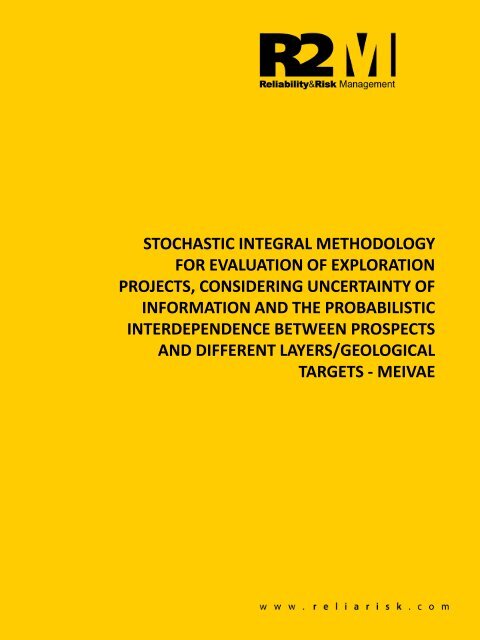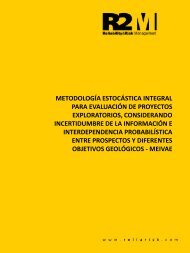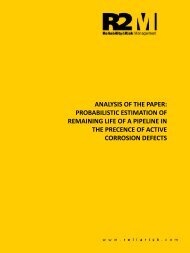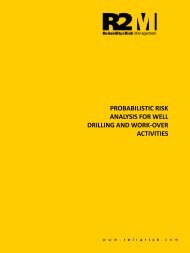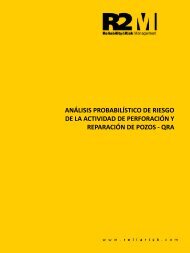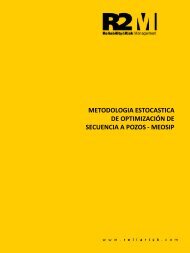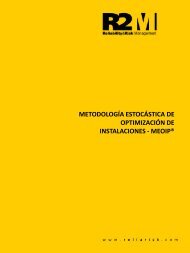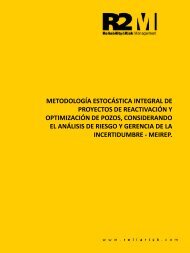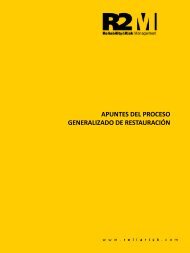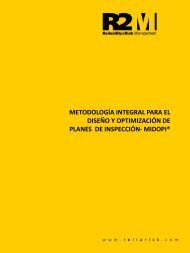Stochastic Evaluation of Exploration Assets - MEIVAE
Create successful ePaper yourself
Turn your PDF publications into a flip-book with our unique Google optimized e-Paper software.
STOCHASTIC INTEGRAL METHODOLOGY<br />
FOR EVALUATION OF EXPLORATION<br />
PROJECTS, CONSIDERING UNCERTAINTY OF<br />
INFORMATION AND THE PROBABILISTIC<br />
INTERDEPENDENCE BETWEEN PROSPECTS<br />
AND DIFFERENT LAYERS/GEOLOGICAL<br />
TARGETS - <strong>MEIVAE</strong>
Medardo Yañez, Karina Semeco, Michele Leccese, Pedro Gil, José Fariñas, Miguel Agüero. 1<br />
“STOCHASTIC INTEGRAL METHODOLOGY FOR EVALUATION OF<br />
EXPLORATION PROJECTS, CONSIDERING UNCERTAINTY OF<br />
INFORMATION AND THE PROBABILISTIC INTERDEPENDENCE BETWEEN<br />
PROSPECTS AND DIFFERENT LAYERS/GEOLOGICAL TARGETS”<br />
Medardo Yañez, Karina Semeco, Michele Leccese, Pedro Gil, José Fariñas, Miguel Agüero.<br />
Reliability and Risk Management México SA de CV– R2M México SA de CV<br />
e-mail: medardo.yanez@reliarisk.com, karina.semeco@reliarisk.com, michele.leccese@reliarisk.com, pedro.gil@reliarisk.com,<br />
jose.farinas@reliarisk.com, miguel.aguero@reliarisk.com<br />
This methodology, fully stochastic in nature, is designed to evaluate and optimize exploration projects that integrate multiple opportunities or<br />
prospects, and to generate a Risk Mitigation Options portfolio with specific actions that affect the critical variables in order to:<br />
<br />
<br />
<br />
Improve Return on Investment <strong>of</strong> Exploratory Projects<br />
Increase Success Probability in Geological Exploratory Campaign<br />
Reduced the OPEX in <strong>Exploration</strong> Projects<br />
The key differentiators <strong>of</strong> the proposed methodology are:<br />
Considers the natural uncertainty <strong>of</strong> information in the exploratory stage and incorporates different techniques to make valid statistical<br />
inference with different types, qualities and quantities <strong>of</strong> information, with emphasis on poor, diffuse or uncertain information.<br />
Establishes optimal drilling sequence that maximizes the value promise associated with a set <strong>of</strong> opportunities, for which considers:<br />
<br />
• Optimal selection <strong>of</strong> prospects that will integrate the project to be developed, seeking the best combination <strong>of</strong> maturity, models<br />
definition level and resources needed to incorporate them.<br />
• <strong>Evaluation</strong> <strong>of</strong> multiple possible sequences <strong>of</strong> activity taking into account the availability <strong>of</strong> drilling equipment, mobilization costs,<br />
availability <strong>of</strong> facilities, among others.<br />
Allows the generation <strong>of</strong> <strong>Stochastic</strong> Production Forecasts and Investment in <strong>Exploration</strong> Wells along with their respective<br />
development Wells in case <strong>of</strong> success, based on the concept <strong>of</strong> Well-Type. It includes the probability tree that considers the<br />
geological success probability for each exploratory location, as well as for the development Wells. It also includes the effect <strong>of</strong><br />
probabilistic dependence between exploration opportunities and between the different geological targets.<br />
Keywords: <strong>Exploration</strong>, Resources, <strong>Stochastic</strong> Estimation, Analog Data, Prospect, Geological Success, Geological<br />
Objective, Geological Interdependence, <strong>Stochastic</strong> Optimization, Drilling, Montecarlo Simulation<br />
1. Introduction<br />
<strong>Exploration</strong> is the term used in the petroleum industry<br />
to describe the search for hydrocarbons. From the<br />
beginning <strong>of</strong> oil exploration to date new and complex<br />
technologies have been developed to infer the<br />
presence <strong>of</strong> hydrocarbons. They have focused on<br />
reducing risk factors, however, it has not yet<br />
managed to develop an inference method to define<br />
or secure the presence <strong>of</strong> hydrocarbons. That is why<br />
to verify the existence <strong>of</strong> hydrocarbons it should be<br />
resorted to the drilling <strong>of</strong> exploratory wells, only then<br />
you can make sure that what was defined as a<br />
"prospect" is and functions as a "hydrocarbon<br />
reservoir."<br />
The "exploration", in the context <strong>of</strong> the oil industry, is<br />
by its nature, the stage at which they handle higher<br />
levels <strong>of</strong> uncertainty, and paradoxically it is also the<br />
stage where decisions are made that affect most (for<br />
better or worse) the project economics.<br />
Historically, the challenge to economically “assess”<br />
exploration and production projects, from the<br />
exploratory phase, was developed with various<br />
methodological approaches that have evolved over<br />
time and from different angles try to deal with the<br />
need to justify high investments with models that<br />
feed on scant, uncertain or fuzzy information.<br />
This feature <strong>of</strong> the exploratory stage implies:<br />
Use <strong>of</strong> probability and statistical inference as pillars<br />
for the possibility estimation.<br />
Use <strong>of</strong> decision models that take into account the<br />
uncertainty <strong>of</strong> the variables, that is, models based on<br />
concepts <strong>of</strong> risk [1],[2].<br />
The use <strong>of</strong> probability and statistical inference in<br />
statistical exploration has evolved from traditional to<br />
Bayesian statistics [1], [2].<br />
NOTE: Bayesian statistics has many applications, but in the<br />
context <strong>of</strong> exploratory world has two particularly important<br />
applications:<br />
1. Conditional probabilities that apply to model the dependence<br />
between prospects and geological targets. This application<br />
will be explained in detail later in the document.<br />
2. Treatment <strong>of</strong> poor, uncertain and/or vague information,<br />
explained below.<br />
The traditional statistics is the science <strong>of</strong> "experience" and we<br />
could say that is the art <strong>of</strong> mathematically shape the experience,<br />
however, a typical problem <strong>of</strong> our time is that we need to make<br />
estimates about processes or “new” situations on which have no<br />
experience or history, or if we do, it is poor or insufficient. In these<br />
cases, we draw on similar experiences <strong>of</strong> "others" that can serve<br />
as a reference, it is filtered and adapted to our reality using our
Medardo Yañez, Karina Semeco, Michele Leccese, Pedro Gil, José Fariñas, Miguel Agüero. 2<br />
common sense, and then we estimate, analyze and decide. It is<br />
important to mention that we almost never decide based entirely<br />
on the experience <strong>of</strong> others, and we do not based only on common<br />
sense or experience. The most usual is to combine both.<br />
Bayesian statistics, through the Bayes theorem allows us to make<br />
these combinations, in a structured way, and mathematically<br />
supported. The theorem allows to treat the experience <strong>of</strong> “others”<br />
as "prior knowledge", usually represented by a probability<br />
distribution, and our experience (own data) or common sense<br />
(expert opinion) as "evidence". Both are mathematically combined<br />
to obtain a modified probability distribution known as “posterior,<br />
improved or updated knowledge”<br />
Meanwhile decision making has gone from using<br />
qualitative risk models to intensive quantitative risk<br />
analysis [3],[4] .<br />
NOTE: Risk Analysis has two distinct schools or trends;<br />
Qualitative or Subjective Indexes School, and Quantitative School.<br />
The Qualitative or Subjective Indexes School uses as a basic tool<br />
<strong>of</strong> analysis a Matrix <strong>of</strong> multiple attributes, whose main product is a<br />
"risk rating (high, medium, low)." The main virtue <strong>of</strong> this trend is<br />
the speed and ease <strong>of</strong> analysis, but its weakness is the subjectivity<br />
and its limitation to be audited.<br />
Quantitative school otherwise uses as a basic tool <strong>of</strong> analysis The<br />
Probabilistic Characterization <strong>of</strong> Information <strong>of</strong> Variables and the<br />
<strong>Stochastic</strong> Modeling Process. The product is a "risk<br />
measurement"; its main virtue is the subjectivity reduction and<br />
improves the traceability <strong>of</strong> the analysis, while its weakness is the<br />
complexity.<br />
The "explorers" are for the oil and gas industry, the<br />
pioneers in the use <strong>of</strong> stochastic models and the<br />
formalization <strong>of</strong> risk analysis as the support science<br />
for decision-making. Clear examples <strong>of</strong> the above are<br />
shown in the following works:<br />
Newendorp P.D. [5] ,“Decision Analysis for Petroleum<br />
<strong>Exploration</strong>”, de1975.<br />
Capen E.C. [6] , “The Difficulty <strong>of</strong> Assessing Uncertainty”, de<br />
1976<br />
Megill R.E. [7] , “An Introduction to Risk Analysis”, de 1984<br />
Rose, Peter R. [8] Dealing with Risk and Uncertainty in<br />
<strong>Exploration</strong> de 1987<br />
Rose, Peter R. [9] , “The Business <strong>of</strong> Petroleum <strong>Exploration</strong>” de<br />
1992.<br />
S.K. Peterson, J.A. Murtha, F.F. Schneider. [10] , “Risk Analysis<br />
and Monte Carlo Simulation Applied to the Generation <strong>of</strong><br />
Drilling AFE Estimates” de 1993.<br />
<br />
Murtha J.A. [11] , “Estimating reserves and Success for a<br />
prospect with geologically dependent layers" – de 1995<br />
Galli A., Armstrong M., Jehl B. [12] , “Comparing Three<br />
Methods for Evaluating Oil Projects Option Pricing, Decision<br />
Trees, and Monte Carlo Simulations” de 1999.<br />
<br />
<br />
Wang B., Kokolis G., Litvak L.B., Rapp W.J. [13] , “Dependent<br />
Risk Calculations in Multiple-Prospect <strong>Exploration</strong><br />
<strong>Evaluation</strong>s” de 2000.<br />
Falla L.C. [14] ,” Probabilistic Model To Develop Multilayer Gas<br />
and Oil Prospects” de 2001<br />
Coordinating Committee for Offshore Prospecting in Asia. [15] ,<br />
“Guidelines for Risk Assessment <strong>of</strong> Petroleum Prospects” de<br />
2001<br />
These works propose approaches that clearly show<br />
the evolution in the use <strong>of</strong> techniques for modeling<br />
uncertainty and risk ranging from simple, to<br />
conditional probabilities, Bayesian probabilities,<br />
probability trees, Monte Carlo simulation and finally<br />
combination <strong>of</strong> decision trees with Monte Carlo<br />
simulation and probabilistic interdependence.<br />
Additionally, these works separately attend various<br />
aspects such as:<br />
Probabilistic Estimation <strong>of</strong> Resources and<br />
Reserves<br />
Probability estimation <strong>of</strong> discovering or<br />
Geological Success Probability.<br />
Probabilistic Dependence among prospects, and<br />
Layers/Geological Targets.<br />
Production Forecast associated to a group <strong>of</strong><br />
opportunities.<br />
Economic <strong>Evaluation</strong> <strong>of</strong> an <strong>Exploration</strong> Project.<br />
In this paper, we present a methodology that<br />
addresses all the above aspects in an integrated<br />
manner, and adds key features to give even more<br />
sense <strong>of</strong> reality to the economic evaluation <strong>of</strong><br />
projects and tools to generate a Risk Mitigation<br />
Options Portfolio comprised with specific actions that<br />
affect the critical variables and aim to:<br />
<br />
<br />
<br />
Improve Return on Investment Exploratory<br />
Projects<br />
Increase Success <strong>of</strong> Geological Exploratory<br />
Campaigns<br />
Reduced the OPEX in <strong>Exploration</strong> Projects<br />
The key differentiators <strong>of</strong> the proposed methodology<br />
are:<br />
Considers the natural uncertainty <strong>of</strong> information<br />
in the exploratory stage and incorporates<br />
different techniques to make valid statistical<br />
inference with different types, qualities and<br />
quantities <strong>of</strong> information, with emphasis on<br />
poor or uncertain information.<br />
Allows the generation <strong>of</strong> feasible scenarios for<br />
resources and reserves incorporation, and<br />
facilitates quick assessment and reduction <strong>of</strong><br />
technically feasible options to a reasonable<br />
number<br />
Establishes optimal drilling sequence that<br />
maximizes the value promise associated with a<br />
set <strong>of</strong> opportunities, for which considers:<br />
• Optimal selection <strong>of</strong> prospects that will<br />
integrate the project to be developed, seeking<br />
the best combination <strong>of</strong> maturity and level <strong>of</strong><br />
definition <strong>of</strong> the models, and resources<br />
needed to incorporate them.<br />
• <strong>Evaluation</strong> <strong>of</strong> multiple possible sequences <strong>of</strong><br />
activity taking into account the availability <strong>of</strong><br />
drilling equipment, mobilization costs and<br />
availability <strong>of</strong> facilities, among others.<br />
Allows the generation <strong>of</strong> <strong>Stochastic</strong> Production<br />
Forecasts and Investment in <strong>Exploration</strong> Wells<br />
along with their respective development Wells,<br />
based on:<br />
• The concept <strong>of</strong> similar Well-Type and the<br />
probability tree that considers the geological<br />
success determined for each exploratory
Medardo Yañez, Karina Semeco, Michele Leccese, Pedro Gil, José Fariñas, Miguel Agüero. 3<br />
<br />
location, the likelihood <strong>of</strong> success <strong>of</strong> its<br />
development Wells and the effect <strong>of</strong><br />
probabilistic dependence between<br />
exploration opportunities, and between<br />
different geological targets.<br />
• Works with double probability in the<br />
simulation, one for the exploratory well, and<br />
another for each <strong>of</strong> the estimated<br />
development Wells required for the reservoir<br />
exploitation, if exploratory localization results<br />
successful (geological and commercially).<br />
<strong>Stochastic</strong> Economic <strong>Evaluation</strong> for each stage<br />
<strong>of</strong> incorporation <strong>of</strong> reserves and resources.<br />
2. Proposed Methodology:<br />
<strong>Stochastic</strong> Integral Methodology for <strong>Evaluation</strong> <strong>of</strong><br />
<strong>Exploration</strong> Projects, Considering Uncertainty <strong>of</strong><br />
Information and the Probabilistic<br />
Interdependence between Prospects And<br />
Different Layers/Geological Targets”, can be<br />
divided into the following stages:<br />
1. Evaluate multiple scenarios for the incorporation<br />
<strong>of</strong> resources and select a set <strong>of</strong> technically<br />
feasible ones.<br />
2. For each scenario <strong>of</strong> incorporation <strong>of</strong> resources:<br />
2.1. Perform the probabilistic estimation <strong>of</strong><br />
Volumes and Resources for each prospect<br />
that integrates the exploration portfolio.<br />
2.2. Estimate the probability <strong>of</strong> geological<br />
success (Pg) for each prospect that<br />
integrates the exploration portfolio,<br />
considering probabilistic dependencies<br />
between prospects and geological targets.<br />
2.3. Generate a Scheduled and Optimized<br />
Drilling program based on:<br />
<br />
<br />
Optimal selection <strong>of</strong> prospects that will integrate the<br />
project to be developed, seeking the best combination <strong>of</strong><br />
maturity and models definition level, and the resources<br />
to be incorporated by them.<br />
<strong>Evaluation</strong> <strong>of</strong> multiple possible sequences <strong>of</strong> activity<br />
taking into account the availability <strong>of</strong> drilling equipment,<br />
mobilization costs and availability <strong>of</strong> facilities among<br />
others.<br />
<strong>Stochastic</strong> Production and Investment<br />
Generation for the Optimized and<br />
Scheduled Drilling Activity,:<br />
<br />
<br />
Daily and Cumulative Production <strong>of</strong> Oil, Water and Gas.<br />
Investments in Exploratory and Development Wells<br />
based on the concept <strong>of</strong> the model <strong>of</strong> “Well-Type”.<br />
2.4. Probabilistic Economic <strong>Evaluation</strong> for the<br />
Optimized Activity.<br />
3. Ranking <strong>of</strong> the evaluated scenarios, and<br />
selection <strong>of</strong> the optimal resource incorporation<br />
one.<br />
The following lines describe and list the most<br />
important technical aspects <strong>of</strong> each <strong>of</strong> the stages:<br />
Stage 1: Evaluate multiple scenarios for the<br />
incorporation <strong>of</strong> resources and select the set <strong>of</strong><br />
technically feasible ones.<br />
Stage 2: <strong>Stochastic</strong> <strong>Evaluation</strong> <strong>of</strong> each selected<br />
scenario.<br />
Stage 2.1: Perform the probabilistic estimation <strong>of</strong><br />
Volumes and Resources [11],[13],[14],[16],[17], for each<br />
prospect that integrates the exploration portfolio.,<br />
The methodology considers the probabilistic<br />
estimation <strong>of</strong> volumes and resources for each<br />
exploratory location based on the procedure<br />
described in Chapters 5 and 6 <strong>of</strong> the "Guidelines for<br />
the <strong>Evaluation</strong> <strong>of</strong> Petroleum Reserves and<br />
Resources SPE 2001”[16]. Figure 1 shows a<br />
schematic <strong>of</strong> the procedure previously mentioned:<br />
Figure 1 – Scheme <strong>of</strong> the Procedure for Probabilistic Estimation <strong>of</strong><br />
Volumes and Resources based on Chapters 5 and 6 <strong>of</strong> the<br />
"Guidelines for the <strong>Evaluation</strong> <strong>of</strong> Petroleum Reserves and<br />
Resources SPE 2001"<br />
Aspects requiring particular attention at this stage<br />
are:<br />
<br />
<br />
<br />
Address rigorously the criteria and concepts <strong>of</strong> the system <strong>of</strong><br />
classification <strong>of</strong> Prospective Resources expressed in the<br />
document "Petroleum Resources Management System<br />
PRMS", endorsed by SPEE: Society <strong>of</strong> Petroleum <strong>Evaluation</strong><br />
Engineers, SPE: Society <strong>of</strong> Petroleum Engineers, WPC:<br />
World Petroleum Council and AAPG: American Association <strong>of</strong><br />
Petroleum Geologists. [18]<br />
Appropriate probabilistic characterization for each <strong>of</strong> the<br />
variables involved in the calculation. The characteristic <strong>of</strong> the<br />
information in the exploratory stage involves using "analog<br />
data" and "expert opinion" because there is "little evidence or<br />
own data <strong>of</strong> the location". This involves intensive Bayes<br />
Theorem usage [1], [2], [3], [4]. Figure 2 outlines the use <strong>of</strong><br />
the aforementioned theorem to estimate the probability<br />
distributions <strong>of</strong> averages <strong>of</strong> properties involved in the<br />
estimation <strong>of</strong> resources.<br />
Consider probabilistic correlations between properties where<br />
applicable, and appropriate truncation <strong>of</strong> probability<br />
distributions in ranges that are "physically possible"
Medardo Yañez, Karina Semeco, Michele Leccese, Pedro Gil, José Fariñas, Miguel Agüero. 4<br />
Figure 2 - Diagram <strong>of</strong> the Procedure for Probabilistic<br />
Characterization <strong>of</strong> the Averages Values <strong>of</strong> the Properties<br />
(porosity, saturation, thickness), from Insufficient Evidence and<br />
Analog Data, with Bayes' Theorem”<br />
<br />
<br />
Properly treat probabilistic dependence between "multiple"<br />
geological targets or "layers" within the same prospect.<br />
References [11], [13], [14] are excellent papers that address<br />
the issue mentioned in detail.<br />
In case <strong>of</strong> requiring the sum <strong>of</strong> resources, it is important to<br />
consider the dependence between prospects and the level <strong>of</strong><br />
uncertainty <strong>of</strong> each estimate, the item is treated in detail in<br />
Chapter 6 <strong>of</strong> reference [16], and is considered a key aspect to<br />
calculate resources.<br />
Stage 2.2: Estimating the Probability <strong>of</strong> Geological Success or<br />
Probability <strong>of</strong> Discovering (Pg) for each prospect that integrates<br />
the <strong>Exploration</strong> Portfolio, considering interdependence between<br />
prospects and geological targets.<br />
To estimate the Probability <strong>of</strong> Geological Success (Pg), it is<br />
established the ranges <strong>of</strong> probability <strong>of</strong> existence <strong>of</strong> each <strong>of</strong> the<br />
processes that are required for the oil system to operate:<br />
<br />
<br />
<br />
<br />
Presence <strong>of</strong> a reservoir or reservoir rock.<br />
Presence <strong>of</strong> a Trap<br />
Presence <strong>of</strong> a Hydrocarbon Charge System<br />
Effective retention <strong>of</strong> oil after migration.<br />
Consequently, the model to estimate the Probability <strong>of</strong> Detection<br />
(Pg) is based on four probabilistic parameters:<br />
<br />
<br />
<br />
<br />
P1: Probability <strong>of</strong> the presence <strong>of</strong> an effective reservoir or<br />
reservoir rock.<br />
P2: Probability <strong>of</strong> the presence <strong>of</strong> an effective Trap.<br />
P3: Probability <strong>of</strong> the presence <strong>of</strong> a Hydrocarbon Loading<br />
System.<br />
P4: Probability <strong>of</strong> an effective retention <strong>of</strong> oil after migration.<br />
Finally, the Probability <strong>of</strong> Discovering (Pg), is estimated with the<br />
following model:<br />
Pg= P1 x P2 x P3 x P4 (1)<br />
Pg= P(Reservoir Rock) x P(Trap) x P(Charge) x P(Retention)<br />
NOTE: The following explains with more detail each <strong>of</strong> these<br />
probabilistic parameters:<br />
<br />
Muestra de<br />
tamaño “m”<br />
H1<br />
H2<br />
H3<br />
H4<br />
H5<br />
.<br />
.<br />
.<br />
.<br />
.<br />
.<br />
Hm<br />
Muestra de<br />
tamaño “n”<br />
h1<br />
h2<br />
h3<br />
.<br />
.<br />
.<br />
.<br />
hn<br />
Prior Knowledge –<br />
Datos Análogos<br />
m<br />
<br />
Hi <br />
i 1 sH<br />
<br />
H<br />
<br />
<br />
.<br />
m<br />
1 <br />
.<br />
m 1<br />
<br />
m<br />
2 <br />
H<br />
i H .<br />
<br />
i 1<br />
H<br />
SH<br />
<br />
g <br />
NormalH , <br />
m <br />
<br />
<br />
<br />
<br />
<br />
S<br />
L<br />
<br />
h<br />
<br />
H<br />
Normal h ,<br />
n <br />
h<br />
n<br />
<br />
hi <br />
i 1<br />
h<br />
<br />
<br />
.<br />
sh<br />
<br />
n<br />
S <br />
H<br />
<br />
m <br />
S <br />
h<br />
<br />
n <br />
1 <br />
.<br />
n 1<br />
<br />
Evidence –<br />
Datos Propios<br />
n<br />
2 <br />
h<br />
i h .<br />
<br />
i 1<br />
m <br />
2<br />
s<br />
<br />
H<br />
H<br />
POSTERIOR <br />
H .....<br />
n m<br />
<br />
2 2<br />
s<br />
s<br />
<br />
h<br />
H <br />
n <br />
2<br />
sh<br />
<br />
.................. <br />
h<br />
n m<br />
<br />
2 2<br />
s<br />
h<br />
sH<br />
<br />
<br />
<br />
POSTERIOR<br />
<br />
<br />
<br />
<br />
1<br />
<br />
<br />
<br />
<br />
n m<br />
2<br />
2 <br />
s<br />
h<br />
s<br />
H<br />
<br />
P1: Probability <strong>of</strong> the presence <strong>of</strong> an effective reservoir<br />
or reservoir rock.<br />
H<br />
Teorema de Bayes<br />
L<br />
H<br />
<br />
<br />
<br />
<br />
<br />
<br />
g <br />
f<br />
<br />
<br />
H <br />
L<br />
H<br />
<br />
<br />
<br />
<br />
g d<br />
<br />
<br />
<br />
Posterior Knowledge –<br />
Información Mejorada<br />
H POSTERIOR<br />
H POSTERIOR<br />
This probability includes two aspects:<br />
The first aspect (P1a): is the probability <strong>of</strong> existence <strong>of</strong> the facies<br />
in the reservoir with the minimal properties such as net / gross and<br />
thickness.<br />
The second aspect (P1b): is the probability that the reservoir rock<br />
has effective properties <strong>of</strong> porosity, permeability and hydrocarbon<br />
saturation.<br />
Finally: P1= P1a x P1b (2)<br />
P2: Probability <strong>of</strong> the presence <strong>of</strong> an effective Trap:<br />
This probability includes two aspects:<br />
The first aspect (P2a): is the probability <strong>of</strong> existence <strong>of</strong> a reservoir<br />
rock volume<br />
The second aspect (P2b): is the probability that there is an<br />
effective seal mechanism for the structure and the trap had<br />
formed.<br />
Finally: P2= P2a x P2b (3)<br />
P3: Probability <strong>of</strong> the presence <strong>of</strong> a Hydrocarbon Charging<br />
System.<br />
This probability includes two aspects:<br />
The first aspect (P3a): is the probability <strong>of</strong> existence <strong>of</strong> a source or<br />
generating rock<br />
The second aspect (P3b): is the probability <strong>of</strong> efficient<br />
migration from the source rock to the trap.<br />
Finally: P3= P3a x P3b (4)<br />
P4: Probability <strong>of</strong> an effective retention <strong>of</strong> oil after migration:<br />
evaluates the probability that the trap has been filled with<br />
hydrocarbon in a given period in time.<br />
The "Guidelines for Risk Assessment <strong>of</strong> Petroleum Prospects" [15] ,<br />
addresses in detail the issue <strong>of</strong> estimating each <strong>of</strong> the parameters<br />
involved in the estimation <strong>of</strong> the (Pg).<br />
The estimate <strong>of</strong> (Pg) for each <strong>of</strong> the prospects that<br />
are part <strong>of</strong> an exploratory portfolio is a known and<br />
dominated aspect by exploratory organizations in the<br />
industry; however, one aspect that requires special<br />
attention in the estimation <strong>of</strong> the (Pg) is to consider<br />
the effect <strong>of</strong> dependency between prospects and<br />
dependence between different geological targets.<br />
NOTE: The probabilistic dependency or "interdependence<br />
between exploration opportunities or prospects" implies that the<br />
result <strong>of</strong> the drilling <strong>of</strong> any <strong>of</strong> the prospects (with success or<br />
failure), impacts the likelihood <strong>of</strong> discovery <strong>of</strong> the others.<br />
The independence between prospects can be assumed for<br />
example in the case that they belong to different geological plays,<br />
but if they belong to the same play, then they should be<br />
considered interdependent.<br />
Such probability calculations are based on conditional probabilities<br />
and are governed by the so-called Bayes Theorem [1], [2], [3], [4], [15] .<br />
To illustrate the effect <strong>of</strong> the interdependence, an example <strong>of</strong> 5<br />
prospects "X" located in an exploratory area and that are<br />
considered exploratory dependent is shown. As explained in the<br />
equations (1), (2), (3) and (4) to estimate the (Pg) is necessary to<br />
consider multiple probabilistic parameters.<br />
In the case <strong>of</strong> interdependent prospects, the factors <strong>of</strong> the above<br />
equation must be separated into two groups; common factors to all<br />
prospects, generating a probability P (S), and factors that are not<br />
common to the different prospects under analysis, generating<br />
different probabilities denoted as P (X / S). In this case, by
Medardo Yañez, Karina Semeco, Michele Leccese, Pedro Gil, José Fariñas, Miguel Agüero. 5<br />
applying Bayes Theorem [1], [2], [15] in its meaning to the<br />
treatment <strong>of</strong> conditional probabilities, the probability <strong>of</strong> finding a<br />
certain prospect "X”, is expressed as:<br />
P(X)=P(S) x P(X|S) (5)<br />
Table 1 shows the estimation <strong>of</strong> the individual probabilities P (X)<br />
for the example <strong>of</strong> 5 prospects.<br />
Probabilistic Factors<br />
Prospect A Pospecto B Prospect C Prospect D Prospect E<br />
P1a Reservoir Facies 0.8 0.8 0.8 0.8 0.8<br />
P1b Porosity 0.6 1.0 0.5 0.8 0.9<br />
P2a Trap Identification 1.0 0.9 0.9 0.7 0.6<br />
P2b Seal 0.9 0.9 0.8 1.0 1.0<br />
P3a Mature Sorce Rock 0.7 0.7 0.7 0.7 0.7<br />
P3b Migration 1.0 0.8 0.9 0.8 0.8<br />
P4 Retention 1.0 1.0 1.0 1.0 1.0<br />
P (B|Ā) = [0.3639 x (1 – 0.54)] / (1 – 0.3024) = 0.239<br />
<br />
Probability <strong>of</strong> Prospect C being successful given that A was a<br />
failure:<br />
P (C|Ā) = [0.1814 x (1 – 0.54)] / (1 – 0.3024) = 0.120<br />
<br />
Probability <strong>of</strong> Prospect D being successful given that A was a<br />
failure:<br />
P (D|Ā) = [0.2509 x (1 – 0.54)] / (1 – 0.3024) = 0.165<br />
<br />
Probability <strong>of</strong> Prospect E being successful given that A was a<br />
failure:<br />
P (E|Ā) = [0.2419 x (1 – 0.54)] / (1 – 0.3024] = 0.160<br />
P(S)=P1a x P3a x P4 Common Factors 0.56 0.56 0.56 0.56 0.56<br />
P(X/S)=P1b x P2a x P2b x P3b Independent Factors 0.54 0.648 0.324 0.448 0.432<br />
P(X)=P(S) x P(X/S) Individuial Probability 0.3024 0.3629 0.1814 0.2509 0.2419<br />
A<br />
Failure<br />
(Dry)<br />
P(A)<br />
1-P(A)=0.698<br />
1<br />
0.698<br />
Table 1 - Shows factors P1a, P3a and P4 common for five<br />
prospects, and P1b, P2a, P2b and P3b, uncommon or<br />
independent for the 5 prospects. This is calculated by P (S) = P1a<br />
x P3a x P4, and P (X / S) = P1b x P2a x P2b x P3b, for each<br />
prospect, to finally obtain the individual probabilities P (A), P (B ),<br />
P (C), P (D) and P (E) using the equation <strong>of</strong> Bayes P (x) = P (S) x<br />
P (x / S).<br />
B<br />
C<br />
Discovery<br />
Failure<br />
Discovery<br />
Failure<br />
P(B P(B/A)=0.648<br />
/<br />
0.239<br />
(1-P(B/A))=0.352<br />
/<br />
0.761<br />
P(C P(C/A)=0.324<br />
/<br />
0.120<br />
(1-P(C/A))=0.676<br />
/<br />
0.880<br />
With the results summarized in Table 1, now it can be estimated<br />
how the individual probabilities are affected, for example in the<br />
case <strong>of</strong> success <strong>of</strong> Prospect A, using the tree shown in Figure 3.<br />
D<br />
Discovery<br />
Failure<br />
P(D P(D/A)=0.448<br />
/<br />
0.165<br />
(1-P(D/A))=0.552<br />
/<br />
0.835<br />
E<br />
Discovery<br />
Failure<br />
P(E P(E/A)=0.432<br />
/<br />
0.160<br />
(1-P(E/A))=0.568<br />
/<br />
0.840<br />
Figure 4 – Trees <strong>of</strong> Conditional Probabilities if Prospect A is a<br />
failure.<br />
Finally, the probabilistic model for the five (5) prospects analyzed<br />
is summarized in probability tree shown in Figure 6.<br />
Figure 3 – Trees <strong>of</strong> Conditional Probabilities if Prospect A is<br />
successful.<br />
If Prospect A is a successful discovering, the probability <strong>of</strong> making<br />
discoveries in B, C, D and E increases because the common<br />
factors are confirmed, that is P (S) = 1, so that P (X) = P (X / S),<br />
which means that the probability <strong>of</strong> detection in B, C, D and E is<br />
governed by the non-common or independent factors.<br />
It can be also calculated how the individual probabilities are<br />
affected in the case that Prospect A fails using the above<br />
mentioned Bayes theorem [1], [2], [15] to construct a tree <strong>of</strong><br />
conditional probabilities as figure 4 shows.<br />
If the prospect is a failure, the probability <strong>of</strong> making discoveries in<br />
B, C, and D is substantially reduced but there is still a remaining<br />
probability. To calculate this probability it is derived from Bayes<br />
Theorem [1], [2], [15] , the following expression:<br />
P(X|Ā) = (P(X) x [1-P(S A)])/[1-P(A)] (6)<br />
The expression implies that the remaining probability <strong>of</strong> success in<br />
a prospect X since A was a failure, P (X | A) is the probability <strong>of</strong><br />
success P (X) affected by the likelihood that failure <strong>of</strong> "A" is due to<br />
independent factors [1-P (SA)].<br />
Applying equation (6) to the prospects B, C, D and E, it is<br />
obtained:<br />
<br />
Probability <strong>of</strong> Prospect B being successful given that A<br />
was a failure:<br />
Figure 6 – Tree <strong>of</strong> Conditional Probability <strong>of</strong> Prospects B, C, D and<br />
E depending on the result in A.<br />
Stage 2.3: Generate a Scheduled and Optimized Drilling Activity.<br />
One factor that contributes most to the success <strong>of</strong> geological,<br />
volumetric and economic <strong>of</strong> exploration campaigns is the selected<br />
sequence <strong>of</strong> drilling activity. The natural tendency is to focus the<br />
efforts on those prospects in which it is estimated a greater<br />
accumulation <strong>of</strong> hydrocarbons and where there is a suspicion <strong>of</strong><br />
hydrocarbon <strong>of</strong> interest to the business strategy, but in this regard,<br />
there are several questions:<br />
<br />
<br />
Have these prospects the best defined models?<br />
How robust is the information used to define the models?
Medardo Yañez, Karina Semeco, Michele Leccese, Pedro Gil, José Fariñas, Miguel Agüero. 6<br />
<br />
<br />
<br />
<br />
What geological risk was defined for each prospect?<br />
Are there any nearby facilities to manage production in case<br />
<strong>of</strong> having a successful discovery?<br />
Is there drilling equipment available for the estimated drilling<br />
date?<br />
What are the costs <strong>of</strong> transportation and conditioning required<br />
for the area to be drilled?<br />
To achieve the "optimal sequence" thousands <strong>of</strong><br />
combinations are performed by a powerful simulation<br />
algorithm until obtaining the combination <strong>of</strong> activities<br />
(sequence) that maximizes pr<strong>of</strong>itability.<br />
To answer these questions and address and some<br />
others in the search for a sequence <strong>of</strong> activities that<br />
aim to maximize value, the proposed methodology<br />
considers two key activities or stages:<br />
Stage 2.3.1: Optimal selection <strong>of</strong> prospects to<br />
integrate the project to be developed. It seeks for the<br />
best combination <strong>of</strong> maturity and models definition<br />
level and resources to be incorporated.<br />
The Reliability or Maturity Index is an indicator that<br />
allows determining the level <strong>of</strong> definition, reliability,<br />
maturity, robustness, and model uncertainty <strong>of</strong> a<br />
prospect. This index or indicator improves prospects<br />
ranking.<br />
Figure 8 - From the optimized portfolio achieved in the previous<br />
stage, the optimal sequence or scheduled activity is generated, by<br />
evaluating multiple possible sequences <strong>of</strong> activity taking into<br />
account the availability <strong>of</strong> drilling equipment, mobilization costs,<br />
and the availability <strong>of</strong> facilities.<br />
Stage 2.4: Generation <strong>of</strong> <strong>Stochastic</strong> Production<br />
Forecasts <strong>of</strong> Oil, Water and Gas and Investment in<br />
<strong>Exploration</strong> Wells and Development Wells.<br />
This stage is based on the following elements:<br />
<br />
The Concept <strong>of</strong> Analog Well – Probabilistic.<br />
NOTE: The production forecast in the life cycle <strong>of</strong> the well is<br />
obtained from the initial quota <strong>of</strong> production that is “declined” at a<br />
rate equivalent to a factor (D) known as “decline factor or rate <strong>of</strong><br />
decline”. The resulting pr<strong>of</strong>ile is also known as "the well decline<br />
curve."<br />
The production decline curve represents a dynamic method to<br />
predict the approximated future production capacity <strong>of</strong> wells,<br />
reservoirs and fields.<br />
Figure 7 - Model (3D Matrix) <strong>of</strong> hierarchy that considers resource<br />
to incorporate, Reliability and Geological Risk Index for each<br />
exploratory location in the exploration portfolio.<br />
From this matrix is possible to select the set <strong>of</strong><br />
prospects that have the best combination <strong>of</strong> resource<br />
to incorporate, Probability <strong>of</strong> geological success (Pg),<br />
and Reliability Index.<br />
The set <strong>of</strong> selected prospects constitutes the activity<br />
that now must be scheduled; but, in which order<br />
should these Wells be drilled in order to obtain<br />
maximum pr<strong>of</strong>itability?. This question is answered in<br />
the next stage.<br />
Figure 10 - Forecast <strong>of</strong> production following an exponential decline<br />
model. Note that the initial quota <strong>of</strong> production (Qo), the<br />
declination (D) and the Well Life time (t) are probabilistically<br />
treated.<br />
The concept <strong>of</strong> Analog Well involves the probabilistic<br />
characterization <strong>of</strong> the behavior <strong>of</strong> the production <strong>of</strong> Wells in an<br />
analog field or reservoir to the prospectus to be drilled.<br />
Stage 2.3.2: <strong>Evaluation</strong> <strong>of</strong> multiple possible<br />
sequences <strong>of</strong> activity selected in the previous stage<br />
taking into account the availability <strong>of</strong> drilling<br />
equipment, mobilization costs and availability <strong>of</strong><br />
facilities among others.<br />
Figure 11- Analog Well: A production model <strong>of</strong> an Analog Well<br />
must reproduce the historical (past) behavior <strong>of</strong> the production <strong>of</strong><br />
the analog field, and collate with the production forecast made for<br />
the new wells.
Medardo Yañez, Karina Semeco, Michele Leccese, Pedro Gil, José Fariñas, Miguel Agüero. 7<br />
<br />
<br />
Optimized and Scheduled Activity <strong>of</strong> Exploratory<br />
Locations.<br />
Probability Tree based on the geological success<br />
determined for each exploratory location, taking<br />
into account the effect <strong>of</strong> dependence between<br />
exploration opportunities as well as the<br />
dependence between different geological targets.<br />
All this information feeds a probabilistic model<br />
created and that resides in a computational tool<br />
which generates:<br />
• The probabilistic production pr<strong>of</strong>ile or the<br />
production forecast band.<br />
• The Comparison <strong>of</strong> the Probabilistic Cumulative<br />
Production Pr<strong>of</strong>ile and the Curve <strong>of</strong> Resources (IR) to<br />
be Incorporated Estimated by <strong>Exploration</strong>.<br />
• The Investments Probabilistic Pr<strong>of</strong>ile, signaling:<br />
<br />
<br />
Investment in <strong>Exploration</strong> Wells<br />
Investments in Development Wells, in case that the<br />
exploratory location will turn out successful.<br />
Figure 12 shows a diagram <strong>of</strong> the process followed<br />
by the previously mentioned computational tool.<br />
It is important to note that the probabilistic tool works<br />
with double probability <strong>of</strong> success in the simulation<br />
(trees <strong>of</strong> probabilities and events). One probability<br />
corresponds to the Exploratory Well and the other<br />
probability to each Development Well <strong>of</strong> the area if<br />
the exploratory location turns out successful.<br />
Figure 13 shows the Probability Tree for the<br />
Development <strong>of</strong> <strong>Exploration</strong> Opportunities.<br />
The center <strong>of</strong> this tree is the Probability Tree <strong>of</strong><br />
Geological Success, which will enable or disable the<br />
Probability Trees <strong>of</strong> the Drilling Activity for<br />
Development Wells.<br />
Figure 12 - Diagram <strong>of</strong> the Methodology for Generation <strong>of</strong><br />
<strong>Stochastic</strong> Production Forecasts.<br />
Figure 13 - Probability Tree <strong>of</strong> Development <strong>of</strong> exploration<br />
opportunities. In a simulation, each time a “one” (1) is generated<br />
from the binomial distribution <strong>of</strong> Geological Success, the binomials<br />
from the Probability Trees <strong>of</strong> the Drilling Activity for Development<br />
Wells will be enabled; since it implies that the prospect is a<br />
reservoir. And each time it generates a “zero” (0) will disable the<br />
binomial distribution <strong>of</strong> the Development Wells mentioned; as this<br />
implies that the exploratory opportunity is not an exploitable<br />
reservoir.<br />
Figure 14 - Extended Production <strong>Stochastic</strong> Forecast, in which can<br />
be distinguished the probabilistic band (P10, P90 and Mean) Day<br />
Average Production, the cumulative production and the traditional<br />
IR Curve estimated by exploration.<br />
Stage 2.5: Probabilistic Economic <strong>Evaluation</strong>.<br />
Based on the production pr<strong>of</strong>ile created (see Figure 14), in parallel,<br />
theses other pr<strong>of</strong>iles are generated: Investments and Income<br />
Probabilistic Pr<strong>of</strong>iles, corresponding to:<br />
• Probabilistic Pr<strong>of</strong>iles <strong>of</strong> Incomes <strong>of</strong> Global <strong>Exploration</strong>.<br />
• Probabilistic Pr<strong>of</strong>iles <strong>of</strong> Investment <strong>of</strong> Global <strong>Exploration</strong>.<br />
• Probabilistic Pr<strong>of</strong>iles <strong>of</strong> Investments for Development Drilling.<br />
• Probabilistic Pr<strong>of</strong>iles <strong>of</strong> Exploratory Investments.<br />
• Probabilistic Pr<strong>of</strong>iles <strong>of</strong> Seismic Investment.<br />
Figure 15 shows the process <strong>of</strong> the Probabilistic Economic<br />
<strong>Evaluation</strong> that takes as inputs the above mentioned stochastic<br />
pr<strong>of</strong>iles.
Medardo Yañez, Karina Semeco, Michele Leccese, Pedro Gil, José Fariñas, Miguel Agüero. 8<br />
Figure 15 – Process <strong>of</strong> the Probabilistic Economic <strong>Evaluation</strong><br />
Stage 3: Rank among the evaluated scenarios, and<br />
selection <strong>of</strong> the optimal resource incorporation<br />
scenario.<br />
Based on the analysis <strong>of</strong> the results for each<br />
evaluated Scenario <strong>of</strong> Resource Incorporation, these<br />
are ranked, and then the one that generates the best<br />
combination between the value generated and risk<br />
involved is selected.<br />
The ranking process is based on extracting from the<br />
NPV and the IPV probability distributions obtained for<br />
each scenario (see Figure 15), three parameters: the<br />
pr<strong>of</strong>itability factor, the risk factor and the investment<br />
efficiency.<br />
<br />
<br />
<br />
The Pr<strong>of</strong>itability Factor is represented by the<br />
mean or expected value <strong>of</strong> the distribution <strong>of</strong><br />
NPV and translates as the expected pr<strong>of</strong>it <strong>of</strong> the<br />
scenario evaluated in a time horizon.<br />
The Risk factor is represented by the standard<br />
deviation <strong>of</strong> the distribution <strong>of</strong> NPV, and reports<br />
how far from the expected pr<strong>of</strong>itability value may<br />
be the actual value <strong>of</strong> the NPV, because the<br />
influence <strong>of</strong> multiple uncertainties affecting the<br />
process <strong>of</strong> production.<br />
The investment efficiency is obtained by dividing<br />
the mean or expected value <strong>of</strong> the NPV between<br />
the mean or expected value <strong>of</strong> the IPV and<br />
translates to the amount <strong>of</strong> dollars to be gained,<br />
for every dollar invested in the exploitation plan.<br />
Table 2 summarizes the most important results <strong>of</strong> the<br />
technical-economic evaluation carried out at 5<br />
scenarios <strong>of</strong> incorporation <strong>of</strong> resources, and Figure<br />
16 shows the three-dimensional matrix that supports<br />
hierarchy.<br />
Escenarios de<br />
Incorporación de<br />
Recursos<br />
Valor Presente de la<br />
Inversión<br />
Media VPI (MM Pesos)<br />
Eficiencia de la<br />
Inversión<br />
Media (VPN / VPI)<br />
Factor de Riesgo<br />
DS VPN Despues Impuesto<br />
(MM Pesos)<br />
Factor de Rentabilidad<br />
después de Impuestos<br />
Media VPN Despues<br />
Impuesto (MM Pesos)<br />
Escenario 1 207,061.79 0.648 14,772.82 134,124.11<br />
Escenario 2 206,988.46 0.645 14,645.11 133,581.50<br />
Escenario 3 206,944.45 0.647 14,724.73 133,989.66<br />
Escenario 4 206,544.78 0.638 14,701.23 131,877.37<br />
Escenario 5 206,914.25 0.648 14,730.09 134,054.15<br />
Table 2 – Results <strong>of</strong> the technical-economic evaluation carried out<br />
at 5 scenarios <strong>of</strong> incorporation <strong>of</strong> resources.<br />
Figure 16 - Three-dimensional Ranking Matrix <strong>of</strong> Resources<br />
Incorporation Scenarios<br />
REFERENCIAS:<br />
1. Martz, H.F.;Walley, R.A. “Bayesian Reliability<br />
Analysis”, John Wiley and Sons, NY, 1982.<br />
2. Yañez, M.E – Semeco, K.L – Medina N.M –<br />
“Enfoque Práctico para la Estimación de<br />
Confiabilidad y Disponibilidad de Equipos, con<br />
base en Datos Genéricos y Opinión de Expertos”<br />
– Universidad Simón Bolívar - Venezuela 2005.<br />
3. Modarres, M; Kaminsky, M; Kritsov, V. “Reliability<br />
Engineering And Risk Analysis”. Marcel Dekker,<br />
New York,1999.<br />
4. Yañez, M.E – Gómez de la Vega, H.A, Valbuena<br />
G, Ingeniería de Confiabilidad y Análisis<br />
Probabilístico de Riesgo – ISBN 980-12-0116-9 -<br />
Junio 2003.<br />
5. Newendorp P.D; Schuyler J.R.: “Decision<br />
Analysis for Petroleum <strong>Exploration</strong>”, 2da Edición,<br />
IBSN 0-9664401-1-1-0, Julio 2000.<br />
6. Capen E.C., “The Difficulty <strong>of</strong> Assessing<br />
Uncertainty”, SPE AIME, 1976<br />
7. Megill R.E., “An Introduction to Risk Analysis”,<br />
2 nd Edition, PennWell Publishing Company, Tulsa<br />
Oklahoma, 1984<br />
8. Rose, Peter R., “Dealing with Risk and<br />
Uncertainty in <strong>Exploration</strong>” de 1987<br />
9. Rose, Peter R.: The Business <strong>of</strong> Petroleum<br />
<strong>Exploration</strong> – AAPG Treatise <strong>of</strong> Petroleum<br />
Geology Handbook <strong>of</strong> Petroleum Geology, 1992<br />
10. Peterson S.K., Murtha J.A., Schneider F.F., “Risk<br />
Analysis and Monte Carlo Simulation Applied to<br />
the Generation <strong>of</strong> Drilling AFE Estimates” –<br />
Paper SPE 26339, 1993.
Medardo Yañez, Karina Semeco, Michele Leccese, Pedro Gil, José Fariñas, Miguel Agüero. 9<br />
11. Murtha J.A.: “Estimating reserves and Success<br />
for a prospect with geologically dependent<br />
layers" – Paper SPE 30040, 1995<br />
12. Galli A., Armstrong M., Jehl B.: “Comparing<br />
Three Methods for Evaluating Oil Projects Option<br />
Pricing, Decision Trees, and Monte Carlo<br />
Simulations” – Paper SPE 52949/57894, 1999<br />
13. Wang B., Kokolis G., Litvak L.B., Rapp W.J.:<br />
“Dependent Risk Calculations in Multile-Prospect<br />
<strong>Exploration</strong> <strong>Evaluation</strong>s” Paper SPE 63198,<br />
2000.<br />
14. Falla L.C.,”Probabilistic Model To Develop<br />
Multilayer Gas and Oil Prospects”, SPE 69614,<br />
2001<br />
15. Coordinating Committee for Offshore Prospecting<br />
in Asia,“Guidelines for Risk Assessment <strong>of</strong><br />
Petroleum Prospects”, 2001<br />
16. “Guidelines for the <strong>Evaluation</strong> <strong>of</strong> Petroleum<br />
Reserves and Resources”, a Supplement to the<br />
SPE/WPC Petroleum Reserves Definitions and<br />
the SPE/WPC/AAPG Petroleum Resources<br />
Definitions - ISBN 978-1-55563-105-5, 2001<br />
17. Capen E.C., “A Consistent Probabilistic Definition<br />
<strong>of</strong> Reserves”; SPE Reservoir Engineering – 1996<br />
18. “Petroleum Resources Management System<br />
PRMS”, avalado por SPEE: Society <strong>of</strong> Petroleum<br />
<strong>Evaluation</strong> Engineers, SPE: Society <strong>of</strong> Petroleum<br />
Engineers, WPC: World Petroleum Council y<br />
AAPG: American Association <strong>of</strong> Petroleum<br />
Geologists. 2007


